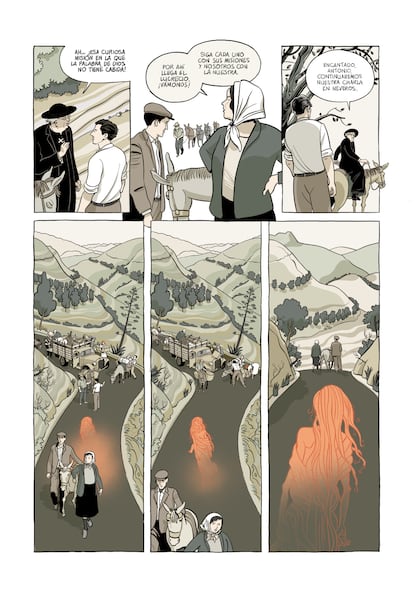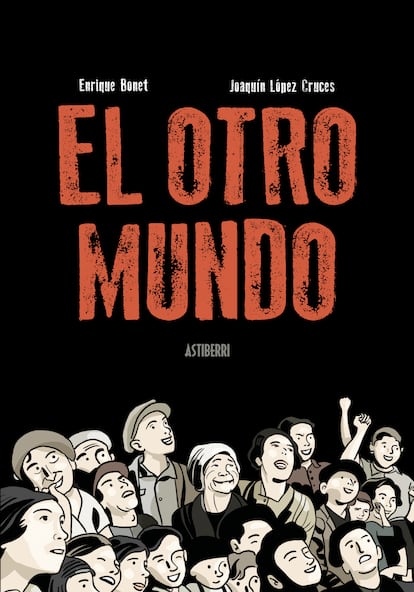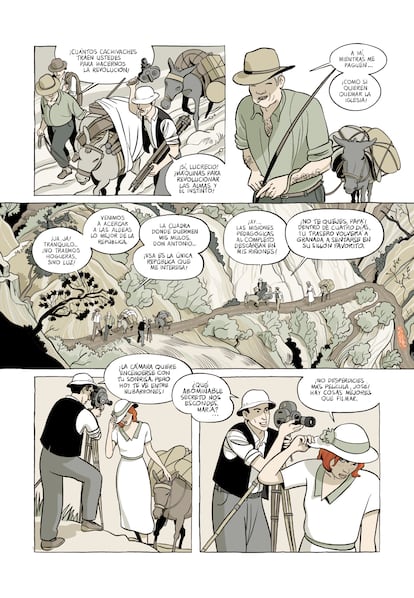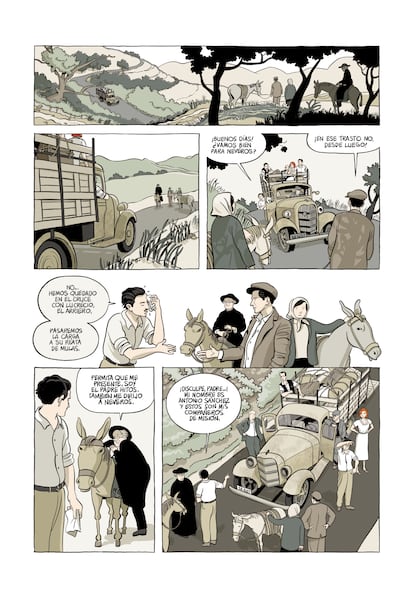Culture, a century ago, was in Spain an urban artifact. Reading, listening to music or watching cinema were chores available only for some privileged city. Beyond, in fields and mountains, attention fell to animals and earth. In surviving. But Manuel Bartolomé Cossío, a student and then director of the Free Teaching Institution, dreamed a project to bring education and culture to those erales of strict survival. The Second Republic, with Niceto Alcalá Zamora in front, bought the dream and put it standing in May 1931, date of birth of the pedagogical missions.
In Granada, one of those missions visited nine towns of the deep Alpujarra in the second half of July 1933. The other world (Astiberri Editions), a graphic novel with a script by Enrique Bonet and drawings by Joaquín López Cruces, imagine how that mission was. Its pages recreate a mixture of reality and fiction that portrays the clash that existed between the people of the city and that of the countryside, between culture and religion and, also, between reality and magic.
Five years ago, Bonet – a comics and comics, in addition to a screenwriter – began this project. He turned to draw something “set in the rural world and included magical elements.” In his search he ran into some black and white images, “from some young man mounted in donkey, loaded with bártulos and walking between the mud,” he recalls. Was Stamps 1932a documentary of the Granada filmmaker José Val del Omar about the pedagogical missions. He felt a “strange fascination with those images” and, at that time, The other world He began to set.
Bonet recalls that he, “as happens to many people, confused the missions with the barracks,” the Lorca University Theater that had an inspiration and similar objectives. Screenwriter and cartoonist launched. The exhibition catalog Pedagogical missions 1931-1936 That the Student Residence on the 75th anniversary of the Missions, in 2006, has been standing, both recognize a fundamental source for their graphic novel. When it comes to starting the story, Bonet opted for a real background comic and fictional characters and locations, although the general scenario, the Alpujarras, and some character here and there they starred in the story.
The background, what happens and why it happens is totally real. The reader is facing a “fiction story that is really a real chronicle of the missions,” explains Bonet. “It is the framework of a story. We accompany the missions, the missionaries for three days, and that gives you enough information” about the missions, Apostille López Cruces. It is he who has made the final decision of the color of this graphic novel, “a reduced chromatic palette, there are no more than ten tones,” clarifies the cartoonist, whose original idea was to do it in black and white until the story was forcing him to add colors. A special case is that of red, which identifies the three female leading characters and helps the reader to understand that their role is different from the rest.

The mission that toured the Alpujarra, and probably all those that toured Spain until its total dismantling after the civil war, was not a triumphant walk town to town. On the contrary, the people of the countryside were little given to foreign news; Even more so, as was the case, they did not have the blessing of ecclesiastical authority.
One of the few real characters of The other world It is Father Milestos. At the beginning of history, Milestos, in his donkey, is on the way to the missionaries and cannot be repressed: “That curious mission in which the Word of God has no place!” Later, the priest gives his version of the mission of each other: “That is why my mission is so important and theirs so dangerous,” he tells those who come with books, cinema and music. Before, one of the missionaries has already reminded him that “our spiritual guides are Homer, Cervantes, Machado, Bach, Falla.”
With regard to authors: Each mission delivered a hundred books to the local school. Another thing is what the teacher would then like to do with them. They also carried theater “De Fantoches”, of puppets, music and cinema. In The other world, The cinema manager is Val del Omar, who, indeed, was there and did that. Avant -garde filmmaker, his friend García Lorca placed him in the missions as a photographer, documentary and projectionist.
But the children are the authentic protagonists of the story and, probably the ones who best received these missions, agree and cartoonist. All testimonies, they say, “talk about children as the great allies of the missions. That is why in our history we turn them into protagonists.” These cultural incursions, on the other hand, used to go from less to more. “The first day nobody was going, then his voice was running and more people were appearing,” says Enrique Bonet.

Joaquín López Cruces draws comics and has shared illustration and graphic drawing for more than 40 years. His task has not been to draw specifically, but to give life to the characters on their way through the Alpujarra. “I am very interested in something that is discussed in the cinema but not in the comic: the direction of actors. The characters must know how to play their role. The position of each one is essential to convey feelings. There are times that I repeat and repeat until I find the perfect attitude.” López Cruces, as Bonet, recognizes that the comic is not exactly a means of careless reading, but asks for a certain concentration: “It demands some intervention or effort of the reader. There are people who do not know how to read us because they do not have that habit and have a hard time interpreting,” concludes López Cruces.

But not everything is drawing in this novel. In its final part, Enrique Bonet writes about the missions and some of his main characters in Granada. And López Cruces gives in the end his “field notebook”, several test pages of his characters and vignettes. And now, just like the missionaries toured the villages of Spain, The other world Ask for a track to fly and reach readers. The authors present it in Granada (Palacio de la Madraza) on Friday, September 26. On October 17 they will do it in Madrid, then Almería, the Zaragoza Comic Hall in December and other stops that will come.

